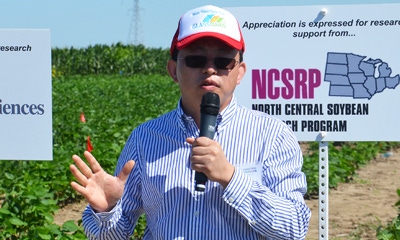
When Jianxin Ma first planted wild soybean lines at the Purdue University Agronomy Center near West Lafayette, he very nearly made one critical error. He didn’t tell the meticulous farm superintendent what he was planting in his research field.
That first year his soybeans looked more like weeds than anything harvested with a combine. The superintendent acknowledged later that he thought they were weeds. Not liking weeds, the superintendent almost sent a crew worker out to mow them before someone told him what was going on in the plot.

TOWARD THE FUTURE: You might not want to grow these beans, but Jianxin Ma is proud of them. He is using the diversity of genes in wild soybeans to help improve modern varieties.
Fortunately, for future soybean production, that didn’t happen. The crosses Ma grows today are beginning to look more like modern-day soybeans. He’s using the untapped diversity of wild soybeans to improve today’s soybean varieties.
Purdue will recognize his work with an award later this year. Meanwhile, he will continue searching for more genes in the wild germplasm related to key agronomic traits.
Purdue’s dean of the College of Agriculture, Jay Akridge, says Ma’s work shows how research can help bring about advances that translate into direct benefits for farmers. Ma has already discovered and characterized many genes in these wild cultivars that underpin key agronomic traits in soybeans. The hope is these traits will improve yield in the future and will lead to changes in plant architecture, disease resistance, resilience to climate change, and improved seed oil and calcium content.
New method tests weed resistance
The time-honored and extremely slow method of confirming weed resistance is to collect seed from plants suspected of being resistant to a herbicide, growing them out in a greenhouse, and then spraying them with various rates of the chemical they might be resistant to.
University of Illinois weed scientist Dean Riechers and a postdoctoral student, Rong Ma, have discovered a much faster way to make the determination. They are currently refining the method and determining exactly how much they can learn from it.
All they need is a single leaf blade, as long as it will fit into a test tube. Their primary research has been on waterhemp, which is spreading across the Midwest. So far they’ve tested their method on both Callisto and Beacon, which are herbicides from different families of weed killers.
How does it work? In laymen’s terms, they expose the leaf to a radioactively labeled herbicide, and then determine how much of the herbicide is left after the leaf has a chance to metabolize it. The less herbicide remaining, the more that was metabolized. The more that was metabolized, the more resistant the plant.
Designer DNA
File this one under one of those agreements reached by a well-known company and a company barely known in ag circles. It may not help your income today, but it just might in the future.
Dow AgroSciences and TeselaGen Biotechnology Inc. will work together to produce a state-of-the-art biological design automation platform.
What does that mean in plain language? This agreement that allows the two companies to work together could speed up discovery work in the biotechnology field.
The goal is to advance development of new crop protection and seed products at an accelerated pace, Dow AgroSciences officials note.
About the Author(s)
You May Also Like




